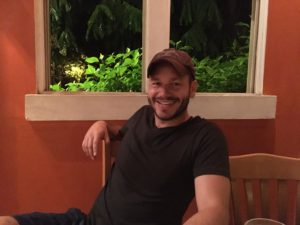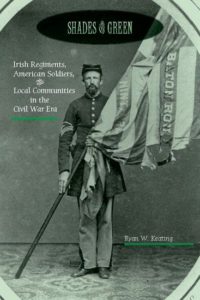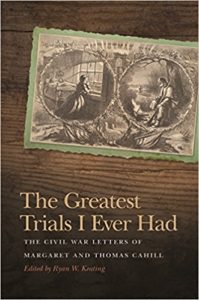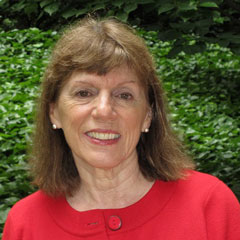 Last Tuesday, Dr. Christopher Dietrich sat down with Dr. Toby C. Jones of Rutgers University and Fordham’s own Dr. Asif Siddiqi to discuss Dr. Dietrich’s new book, Oil Revolution: Anticolonial Elites, Sovereign Rights, and the Economic Culture of Decolonization (Cambridge University Press, 2017). The event quickly became standing-room only as undergraduates, graduates, faculty, and reporters filled the South Lounge at Fordham’s Lincoln Center campus. According to Dr. Dietrich, Continue reading
Last Tuesday, Dr. Christopher Dietrich sat down with Dr. Toby C. Jones of Rutgers University and Fordham’s own Dr. Asif Siddiqi to discuss Dr. Dietrich’s new book, Oil Revolution: Anticolonial Elites, Sovereign Rights, and the Economic Culture of Decolonization (Cambridge University Press, 2017). The event quickly became standing-room only as undergraduates, graduates, faculty, and reporters filled the South Lounge at Fordham’s Lincoln Center campus. According to Dr. Dietrich, Continue reading
Tag Archives: faculty publications
Dr. Christopher Dietrich and the Oil Revolution
Comments Off on Dr. Christopher Dietrich and the Oil Revolution
Filed under Department Events, Events, Faculty News, O'Connell Initiative
Thinking About the History of the Digital Era at the Society for the History of Technology
 Philadelphia was the location on the weekend of October 26-29 for the annual meeting of the Society for the History of Technology (SHOT). For the conference, Professor Asif Siddiqi organized a panel titled “Democratizing the Technologies of Pop Music: Songs in the Key of Gender, Fandom and Digital Sampling.” The panel forms the basis for a new book project by Professor Siddiqi, a collection of essays provisionally titled One Track Mind. The book will bring together academics and cultural critics to talk about Continue reading
Philadelphia was the location on the weekend of October 26-29 for the annual meeting of the Society for the History of Technology (SHOT). For the conference, Professor Asif Siddiqi organized a panel titled “Democratizing the Technologies of Pop Music: Songs in the Key of Gender, Fandom and Digital Sampling.” The panel forms the basis for a new book project by Professor Siddiqi, a collection of essays provisionally titled One Track Mind. The book will bring together academics and cultural critics to talk about Continue reading
Comments Off on Thinking About the History of the Digital Era at the Society for the History of Technology
Filed under Alumni News, Conferences, Department Events, Digital Resources, Essays in History, Events, Faculty News
Fordham Professors in the News
 Dr. Saul Cornell, the Paul and Diane Guenther Chair in American History, the author of A Well-Regulated Militia: The Founding Fathers and the Origins of Gun Control in America, and a recognized authority on the Second Amendment, has recently published two online articles about the gun debate: “Gun Anarchy and the Unfree State, the Real History of the Second Amendment” in The Baffler (October 3), and in Salon (October 22), “Five Types of Gun Laws the Founding Fathers Loved: Were muskets in 1777 better regulated than assault rifles in 2017?”
Dr. Saul Cornell, the Paul and Diane Guenther Chair in American History, the author of A Well-Regulated Militia: The Founding Fathers and the Origins of Gun Control in America, and a recognized authority on the Second Amendment, has recently published two online articles about the gun debate: “Gun Anarchy and the Unfree State, the Real History of the Second Amendment” in The Baffler (October 3), and in Salon (October 22), “Five Types of Gun Laws the Founding Fathers Loved: Were muskets in 1777 better regulated than assault rifles in 2017?”
 Dr. Asif Siddiqi’s highly regarded book, Challenge to Apollo: The Soviet Union and the Space Race, 1945-1974, was quoted in a recent New Yorker article. The article, “Remembering Laika, Space Dog and Soviet Hero” (November 3, 2017) quoted Dr. Siddiqi’s description of the stringent requirements that Soviets followed in choosing dogs for the space mission.
Dr. Asif Siddiqi’s highly regarded book, Challenge to Apollo: The Soviet Union and the Space Race, 1945-1974, was quoted in a recent New Yorker article. The article, “Remembering Laika, Space Dog and Soviet Hero” (November 3, 2017) quoted Dr. Siddiqi’s description of the stringent requirements that Soviets followed in choosing dogs for the space mission.
 Dr. Steven Stoll’s forthcoming new book, Ramp Hallow: The Ordeal of Appalachia (Hill and Wang) received an in-depth review in Washington Monthly, published jointly with ProPublica (October 30). As described by the reviewer, Stoll, “has set out to tell the story of how the people of a sprawling region of our country—one of its most physically captivating and ecological bountiful—went from enjoying a modest by self-sufficient existence as small- scale agrarians for much of the eighteen and nineteenth centuries to a dreary dependency on the indulgence of coal barons or the alms of government.” Dr. Stoll will discuss his new book at The New School on November 13.
Dr. Steven Stoll’s forthcoming new book, Ramp Hallow: The Ordeal of Appalachia (Hill and Wang) received an in-depth review in Washington Monthly, published jointly with ProPublica (October 30). As described by the reviewer, Stoll, “has set out to tell the story of how the people of a sprawling region of our country—one of its most physically captivating and ecological bountiful—went from enjoying a modest by self-sufficient existence as small- scale agrarians for much of the eighteen and nineteenth centuries to a dreary dependency on the indulgence of coal barons or the alms of government.” Dr. Stoll will discuss his new book at The New School on November 13.
Comments Off on Fordham Professors in the News
Filed under Essays in History, Faculty News, Publications, This week in Fordham History
Hamlin on the Building of Germany’s “Empire in the East”
 Big news from Fordham History’s Professor David Hamlin! On 13 July, Cambridge University Press published Germany’s Empire in the East; Germans and Romania in an Era of Globalization and Total War. Where many studies of European empire in the twentieth century focus on imperial projects in the global south, Professor Hamlin’s book demonstrates the place of central and eastern Europe in that story and the important role of economic forces played in shaping global empires. The book tells how the Germans, when “confronted with the global economic and political power of the western allies… turned to Eastern Europe to construct a dependent space, tied to Germany as Central America was to the US.” We reached out to Hamlin for some comments on the process and how the ideas for the book emerged. Continue reading
Big news from Fordham History’s Professor David Hamlin! On 13 July, Cambridge University Press published Germany’s Empire in the East; Germans and Romania in an Era of Globalization and Total War. Where many studies of European empire in the twentieth century focus on imperial projects in the global south, Professor Hamlin’s book demonstrates the place of central and eastern Europe in that story and the important role of economic forces played in shaping global empires. The book tells how the Germans, when “confronted with the global economic and political power of the western allies… turned to Eastern Europe to construct a dependent space, tied to Germany as Central America was to the US.” We reached out to Hamlin for some comments on the process and how the ideas for the book emerged. Continue reading
Comments Off on Hamlin on the Building of Germany’s “Empire in the East”
Filed under Faculty News, Publications
Wabuda Sheds New Light on the Dynamic Archbishop Thomas Cranmer
 This week sees the publication of Professor Susan Wabuda‘s new study of the life and career of the archbishop of Canterbury Thomas Cranmer (1489-1556). Professor Wabuda was interviewed by the book’s publisher Routledge and you can read that interview on their website. We took the opportunity to ask Professor Wabuda some questions of our own about how the new book relates to her earlier research and the ways that it intersects with her teaching and other projects at Fordham.
This week sees the publication of Professor Susan Wabuda‘s new study of the life and career of the archbishop of Canterbury Thomas Cranmer (1489-1556). Professor Wabuda was interviewed by the book’s publisher Routledge and you can read that interview on their website. We took the opportunity to ask Professor Wabuda some questions of our own about how the new book relates to her earlier research and the ways that it intersects with her teaching and other projects at Fordham.Comments Off on Wabuda Sheds New Light on the Dynamic Archbishop Thomas Cranmer
Filed under Faculty News, Publications
Congratulations to Dr. Ryan Keating (Ph.D ’13)
 Congratulations to Fordham alumnus Dr. Ryan Keating for his recent award as “Outstanding Junior Faculty Member.” Dr. Keating received his Ph.D from Fordham in 2013 for his dissertation, “’Give Us War in Our Time’: America’s Irish Communities in the Civil War Era.” He is an assistant professor at California State University San Bernardino in sunny southern California where he received the annual award.
Congratulations to Fordham alumnus Dr. Ryan Keating for his recent award as “Outstanding Junior Faculty Member.” Dr. Keating received his Ph.D from Fordham in 2013 for his dissertation, “’Give Us War in Our Time’: America’s Irish Communities in the Civil War Era.” He is an assistant professor at California State University San Bernardino in sunny southern California where he received the annual award.
On top of showing his Fordham trained teaching chops, Dr. Keating has become an administrative asset for CSUSB. He was named Dean’s Fellow and charged with coordinating the college’s assessment policies. He also co-chairs the University’s Graduation Initiative.
 This does little to detract form his own research it seems, as Dr. Keating has found time to publish two forthcoming books on top of his other projects. The first book, Shades of Green: Irish Reginments, American Soldiers, and Local Communities in the Civil War Era is a social history that traces the soldiers who served in three Irish regiments from Connecticut, Illinois, and Wisconsin, and moves the historical discussion of 19th century Irish immigration away from major urban centers to illustrate ways in which immigrants across the nation understood their place in 19th century America and the meaning of their service in the Civil War.
This does little to detract form his own research it seems, as Dr. Keating has found time to publish two forthcoming books on top of his other projects. The first book, Shades of Green: Irish Reginments, American Soldiers, and Local Communities in the Civil War Era is a social history that traces the soldiers who served in three Irish regiments from Connecticut, Illinois, and Wisconsin, and moves the historical discussion of 19th century Irish immigration away from major urban centers to illustrate ways in which immigrants across the nation understood their place in 19th century America and the meaning of their service in the Civil War.  His second book, The Greatest Trial I Ever Had: The Civil War Letters of Margaret and Thomas Cahill will be an edited collection of letters written by Thomas Cahill, Colonel of the 9th Connecticut Volunteer Infantry, and his wife, Margaret, during the Civil War. This collection represents the largest corpus of letters written by an Irish-American woman during this period to ever be published. The collection also shows the unique perspective on the war from the 9th Connecticut, an Irish regiment that was stationed in the Gulf of Mexico and Louisiana throughout the war, during occupational duty in the south. With these two soon-to-be-published works in his rearview mirror, Dr. Keating has focused on an upcoming study of 500 union veterans who relocated to southern California after their muster out of northern armies.
His second book, The Greatest Trial I Ever Had: The Civil War Letters of Margaret and Thomas Cahill will be an edited collection of letters written by Thomas Cahill, Colonel of the 9th Connecticut Volunteer Infantry, and his wife, Margaret, during the Civil War. This collection represents the largest corpus of letters written by an Irish-American woman during this period to ever be published. The collection also shows the unique perspective on the war from the 9th Connecticut, an Irish regiment that was stationed in the Gulf of Mexico and Louisiana throughout the war, during occupational duty in the south. With these two soon-to-be-published works in his rearview mirror, Dr. Keating has focused on an upcoming study of 500 union veterans who relocated to southern California after their muster out of northern armies.
Once again, congratulations to Dr. Keating on his outstanding award and we will all be looking forward to his future publications!
Comments Off on Congratulations to Dr. Ryan Keating (Ph.D ’13)
Filed under Alumni News, Publications, Teaching
The Professor and the Process: Rosemary Wakeman and Practicing Utopia
 This last year, the department’s own Professor Rosemary Wakeman published her examination of the twentieth-century new town movement with the University of Chicago Press. Practicing Utopia: An Intellectual History of the New Town Movement tracks the global phenomenon as it ignored traditional political and geographic boundaries as each location strived for its own vision of an idealized city.
This last year, the department’s own Professor Rosemary Wakeman published her examination of the twentieth-century new town movement with the University of Chicago Press. Practicing Utopia: An Intellectual History of the New Town Movement tracks the global phenomenon as it ignored traditional political and geographic boundaries as each location strived for its own vision of an idealized city.
Discussing another historian’s work, from its inception to completion and the problems they encounter along the way, personally helps me realize my own research may be more fantastic reality rather than realistic fantasy (you mean I’m not the only one who feels like they spend more time than necessary getting archival permission?). Thankfully, Dr. Wakeman was able to take some time away from her schedule to discuss with me the process and problems for Practicing Utopia.
History Department: So how did the research for this book begin?
Rosemary Wakeman: Like many projects, I begin research while writing on Paris and its postwar development. The housing crisis and new towns in the Paris region led to the overwhelming sources on new towns in Europe, the Middle East, Africa, Asia. It was impossible not to follow the trail.
HD: So what began in Paris developed into a worldwide study? How long did it take then to write the book?
RM: The book was written during a year-long fellowship at the Netherlands Institute for Advanced Study in the Humanities and Social Sciences (NIAS) in Wassenaar, the Netherlands. Another 8+ months followed hunting for images and permissions, working with the editors at the University of Chicago Press to put together the final version.
HD: As a book that developed from Paris into a worldwide study, where does this fit into your overall research?
RM: My longstanding interest is in European urban history, especially the second half of the 20th century. The new towns book gave me the chance to explore urban history, architecture and urban planning in central and eastern Europe.
HD: Did exploring these topics then lead you into any new avenues of research?
RM: This has led to a new project on An Urban History of Europe, 1815 to the Present, which will be published by Bloomsbury Press. Another upcoming project speaks to my interest in continuing a global perspective and will examine the connections between Bombay, London, and Shanghai in the mid-20th century.
HD: It sounds like the trail hasn’t ended then. Have there been any bumps in that trail, such as problems that kept you awake at night dreading some aspect of the project?
RM: What kept me up at night was the choice of which new towns and architect-planners to include in the book and how to organize them around an intellectual history. Finding images and permissions was also difficult. Nonetheless, the project was an opportunity to be in contact with archivists and researchers in new towns literally all over the world. This was an immense pleasure and one of the great benefits of doing historical research.
Thanks so much to Professor Wakeman for taking the time to answer our questions.
When she is not away writing wonderful books, Professor Wakeman teaches frequently in the History graduate program and has served as Director of the O’Connell Initiative in the History of Global Capitalism.
Comments Off on The Professor and the Process: Rosemary Wakeman and Practicing Utopia
Filed under Faculty News, Faculty Profiles, Publications
The Professor and the Process: Dr. Richard Gyug and The Bishop’s Book of Kotor

Liturgy and Law in a Dalmatian City
The Bishop’s Book of Kotor (Sankt-Peterburg, BRAN, F. no. 200).
ISBN: 978-0-88844-204-8
The History Department was lucky enough to catch up with its very own Prof. Richard Gyug to discuss his newest book, Liturgy and Law in a Dalmatian City: The Bishop’s Book of Kotor (Sankt-Peterburg, BRAN, F. no. 200). Prof. Gyug has recently returned to campus after a semester’s leave. He has been research fellow at the Pontifical Institute of Medieval Studies (PIMS) where he continued work on his long-running funded project the Monumenta Liturgica Beneventana. Our interview with Prof. Gyug will hopefully give hope and insight to many scholars, especially those starting out like the Fordham MA students now beginning their spring projects, as we discussed the process: how does a project move from an idea to a finished product like a book?
History Department: First thing’s first I suppose, how did the project begin?
Dr. Richard Gyug: The present volume is a study and edition of a medieval manuscript. A much shorter version of the study and two of the four parts of the edition were my doctoral dissertation at the University of Toronto (1984). The manuscript on which the edition is based is cited several times before 1800 when it was still in Kotor in Montenegro, where it was written and used in the middle ages. After that it disappeared until being noted again by Ljudmila Kisseleva of the Academy of Science in St. Petersburg (then Leningrad). Because the manuscript is written in Beneventan script, which was used in southern Italy and Dalmatia from 800 to 1300 or so, after Kisseleva’s note Virginia Brown listed the manuscript in her 1980 revised edition of E.A. Lowe’s The Benventan Script (original edition 1914). I was then at the Pontifical Institute of Mediaeval Studies in Toronto, where Brown was, and her colleague, Roger Reynolds, introduced the manuscript to me in a seminar. I continued to work on it, and made it my dissertation.

Plate 4 from Gyug, Liturgy and Law. This is fol. 70v in the Pontifical of Kotor (St. Petersburg, RASL, F. 200) and is part of the dedication of a church with notated antiphons and an added communal document. The photograph is by Alexander Karnachov © Sankt-Peterburg, BRAN.
HD: After finally being introduced to the manuscript, how long was the process and its different stages?
RG: Very long! In preparing that dissertation, I noted which parts of the manuscript had music, but did not study them, an omission typical of liturgical editions then and now. At the defense, Andrew Hughes, a distinguished musicologist, noted this lack and stressed how important the music was for understanding the composition and use of the book. Of course, he was correct, so before continuing work on the present book, I edited a missal from Dubrovnik in which music was a major component. After that book came out, I worked on other similar manuscripts associated with a long-term grant-funded project, the Monumenta Liturgica Beneventana, of which I was a member with the late Virginia Brown and Roger Reynolds. I picked up the present manuscript again in the mid-1990s and have been working on it off and on since over several research leaves.
HD: This manuscript seems like a regular in your research. Where does the book and this research fit in to your broader research questions?
RG: It’s a liturgical manuscript in Beneventan script. Such manuscripts are the principal topic of the Monumenta Liturgica Beneventan project, so it’s been a key part of the team project.
HD: Did your research on this book lead you into any immediate upcoming projects? If so, would you care to share what those are?
RG: I have continued to work on Beneventan manuscripts from Italy and Dalmatia, and thanks to the comparisons needed for the edition, also on liturgical manuscripts in other scripts from the region. So, it has led to several projects:
(1) a partial edition and study of a Beneventan manuscript containing Breviary and Ritual, which is priest’s manual. This manuscript is extraordinary because it was written in the fourteenth century, late for Beneventan, for use in Albania, which was outside the Beneventan zone, and the manuscript contains a Franciscan liturgy, rare in Beneventan, which is usually Benedictine and monastic. This study was begun and almost completed by my late colleague Virginia Brown, and I am finishing it at her request.
(2) a study of the relationships between Benevetan manuscripts with similar contents (i.e., the services proper to a bishop) and several related non-Beneventan manuscripts from Norman-Sicily, Bari in southern Italy, and Dubrovnik and Trogir in Dalmatia.
(3) the cataloguing of liturgical and other fragments at Montecassino
Thanks to Professor Gyug for taking the time to talk with us, and congratulations on this handsome book!
Comments Off on The Professor and the Process: Dr. Richard Gyug and The Bishop’s Book of Kotor
Filed under Faculty News, Faculty Profiles, Publications
Interview with Dr. Asif Siddiqi on the Soviet Space Program
 Fordham’s own Dr. Asif Siddiqi recently spoke to New Books Network about his latest monograph, The Red Rockets’ Glare: Spaceflight and the Soviet Imagination 1857-1957 (Cambridge University Press, 2013) in which he examines the long history of space travel in Russian culture. Click here to listen to the full interview at the New Books Network website.
Fordham’s own Dr. Asif Siddiqi recently spoke to New Books Network about his latest monograph, The Red Rockets’ Glare: Spaceflight and the Soviet Imagination 1857-1957 (Cambridge University Press, 2013) in which he examines the long history of space travel in Russian culture. Click here to listen to the full interview at the New Books Network website.
Comments Off on Interview with Dr. Asif Siddiqi on the Soviet Space Program
Filed under Faculty News
Major New Article Explores Race, Sexual Exploitation, and Anti-Colonial Nationalism in Colonial Ghana
In a new article published this month in the American Historical Review, Carina Ray explores the connections between racialized sexual exploitation and anti-colonial nationalism.
Comments Off on Major New Article Explores Race, Sexual Exploitation, and Anti-Colonial Nationalism in Colonial Ghana
Filed under Faculty News

